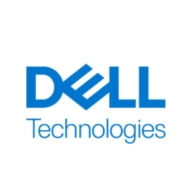

Dell PowerProtect DD and NetApp Cloud Backup compete in the data protection and backup market. Dell PowerProtect DD has the upper hand in pricing, customer support, and ROI, while NetApp Cloud Backup stands out for its feature-rich offerings with advanced functionality.
Features: Dell PowerProtect DD offers robust deduplication capabilities, efficient data protection, and seamless integration into existing IT environments. NetApp Cloud Backup provides cloud-native features, real-time data access, and comprehensive data management tools, making it a favored choice for cloud integration.
Ease of Deployment and Customer Service: Dell PowerProtect DD ensures straightforward deployment and strong customer service, facilitating a smooth onboarding process. NetApp Cloud Backup also allows for efficient deployment, supporting complex cloud migrations and offering specialized support for large-scale environments.
Pricing and ROI: Dell PowerProtect DD is cost-effective with a pricing structure that enhances ROI through data deduplication and storage reduction. NetApp Cloud Backup has higher initial setup costs but provides significant ROI by reducing downtime and delivering robust data insights, justifying its price for cloud-first operations.
I have encountered an issue before with other brands that would not have occurred with Dell.
I have dedicated support from Dell for Vietnam, and they are responsive.
They respond within 24 hours of case submission, which is crucial for maintaining the solution.
The scalability depends on the IT department's strategy.
By keeping the increasing data in mind, we decided to go for Data Domain.
The solution is scalable to higher models, both vertically and horizontally.
Dell is especially more stable in the enterprise product.
Dell PowerProtect DD (Data Domain) is stable in terms of software performance.
It is suitable for more customers since it is small, cost-effective, and a good start for any customer to know about Data Domain and DBS solutions.
Competitors offer dual controller architectures with end-to-end NVMe and Rocky-based back-end network infrastructure.
Medium-level and SME-level businesses can easily utilize this feature, but Dell PowerProtect DD (Data Domain) is a relatively expensive solution to propose to customers.
It is almost four times the earlier price.
The backup solution cost is higher than the actual solution.
The price for PowerProtect DD is not suitable for my customers. It is very high.
The most valuable feature of Dell PowerProtect DD (Data Domain) is its deduplication capability.
Dell PowerProtect DD (Data Domain) is highly consistent, durable, easy to install, scalable, and compatible with any software today.
By using Data Domain, we get the advantage of data deduplication, reducing data size.
| Product | Market Share (%) |
|---|---|
| Dell PowerProtect DD (Data Domain) | 27.2% |
| NetApp Cloud Backup | 1.2% |
| Other | 71.6% |


| Company Size | Count |
|---|---|
| Small Business | 32 |
| Midsize Enterprise | 21 |
| Large Enterprise | 32 |
Dell PowerProtect DD (Data Domain) is a trusted backup appliance, offering advanced data protection through efficient deduplication and compression technologies, ensuring seamless integration and cyber resilience.
Built for both traditional and modern workloads, Dell PowerProtect DD provides a powerful backup solution with reliable protection, high performance, and reduced operational risk. It streamlines backup processes while enhancing data capacity and security through features like DD Boost and multi-platform compatibility. Users benefit from its robust ransomware defense and encryption capabilities. Despite challenges like high pricing and complex setups, it integrates effectively with backup software and offers capabilities such as efficient deduplication, data compression, and multi-site data replication.
What are some key features of Dell PowerProtect DD?Dell PowerProtect DD plays a vital role in sectors like banking, healthcare, and enterprise environments, supporting critical workload protection and seamless data recovery. It integrates with systems like NetWorker and Veeam for efficient operations, proving essential in environments where multi-site data replication is crucial.
NetApp Cloud Backup is a fully integrated service for cloud backup and restoration. It was created to comply fully with NetApp's native data management software ONTAP, used for hybrid cloud experience. NetApp Cloud Backup is used to create backup and restoration for the protection and archiving of data, databases, and virtual machines related to the Cloud and On-Premises data in ONTAP. The way NetApp Cloud Backup works is by automatically creating block-level incremental backups. This ensures that the created backups are very fast and easy to restore. It is suitable for data protection regarding on-premises software as well as in the public cloud. NetApp Cloud Backup provides users with the ability to protect their cloud data at affordable prices and with a user-friendly interface so they don't need a lot of technical knowledge to be able to secure their cloud storage.
The copies created by NetApp Cloud Backup can be stored in the user's personal object storage in the cloud as well as on premises with StorageGRID - NetApp's storage platform. The backup copies can be restored to the original source or to a different source in Cloud Volumes ONTAP. NetApp Cloud Backup provides backups to AWS, Azure, and Google Cloud.
The features NetApp Cloud Backup provides include:
In addition to enhanced security and protection from malicious attacks, the advantages of using NetApp Cloud Backup include:
Abbasi P., a User at a financial services firm, likes that NetApp Cloud Backup is a completely agentless solution.
A Service Manager at a tech services company values its stability, scalability, and good technical support.
We monitor all Deduplication Software reviews to prevent fraudulent reviews and keep review quality high. We do not post reviews by company employees or direct competitors. We validate each review for authenticity via cross-reference with LinkedIn, and personal follow-up with the reviewer when necessary.